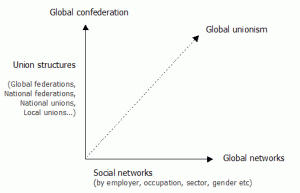
Discussing Global Unionism II: The Social Network Model
Below we are re-posting the second paper of the very timely discussion on how to form truly global unions -instead of international federation of national unions. The discussion has been recently launched by the New Unionism Network and you can read other papers here.
The union movement and FaceBook are about the same size, as of October 2012. That’s about one billion members, or one seventh of the world’s population[1]. It’s a milestone that has attracted very little attention because, frankly, the comparison ends there.

But why?
In this discussion the author argues for a new type of social networking — one which takes great care to protect the user while actively promoting honesty and openness. This combination of safety and collegiality is vital if working people are to build international networks; it is all too easy to forget the real hazards faced by many who need a collective voice. Adding a social network layer to our existing model of unionism would also create a horizontal base, and bring tremendous new strength to the existing vertical structures.
![]()
Unlike FaceBook, the union movement grew organically, almost always in the face of resistance. The “new unionism” of the late 19th century ushered in an age of industrial unions, and by the beginning of the 20th century we were uniting workers and federating their unions along regional, sectoral and national lines. The first experiments with international structures began to appear in the very earliest years of the twentieth century. Back then, comparisons with FaceBook might have made sense.



